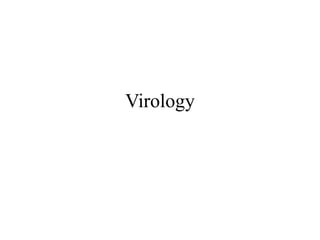
Principles of Virology.ppt
- 1. Virology
- 2. Properties of Viruses • Contain a single type of nucleic acid, either DNA or RNA, not both. The DNA and RNA can either be double stranded (ds) or single stranded (ss) depending upon the virus. • Surrounded by a protein coat called a capsid. – Capsids made up of smaller units called capsomeres. • Some are enveloped, meaning that the capsid is surrounded by another layer made up of lipids, proteins, and carbohydrates. – Only animal viruses have envelopes. Animal viruses are viruses capable of infecting humans as opposed to phages, which infect bacteria.
- 3. – Some enveloped viruses may be covered in “spikes”. Spikes are protein or carbohydrate complexes used for attachment to the target cell. – Spikes can mutate and then the virus can reinfect the same individual. Influenzavirus is an example of a virus that does this. • Viruses multiply inside living cells using cell machinery to replicate nucleic acid and make proteins. • Viruses cause synthesis of specialized structures that can transfer viral nucleic acid to other cells
- 4. General Morphology • There are some general shapes that animal viruses tend to have. • Helical: see figure 6.5 for a great description of this structure. • Polyhedral: has multiple sides. An example of a polyhedral shape is icosahedral. • Complex virus: this is a virus that does not fit into one of the above categories. An example of this kind of virus would be a bacteriophage
- 5. • Virion: A virion is a complete, fully developed, infectious viral particle. • Host Range: Each virus has a different host range. The host range is the number of different host cells a virus can infect. – The attachment proteins on the outside of the virus determine the host range for a virus. If they are compatible with proteins on the host cell membrane found on many cells then the host range will be large. If the viral proteins are only compatible with a protein found on a few host cell membranes then the host range will be small.
- 6. Cultivation • Since viruses are obligate intracellular pathogens tissue cultures have to be grown in order to cultivate viral particles. – Tissue cultures are started with small tissue samples of organs that viruses are known to infect, such as kidney or lung cells. • Primary cell line: The initial tissue sample that is used to start a tissue culture, derived from tissue slices is called the primary cell line. – Generally tissue samples last only a few generations.
- 7. • Continuous cell lines: transformed, or altered, cells (cancerous) can be maintained through an indefinite number of generations. Essentially a cancerous cell is one in which the programmed cell death response has been turned off. The cell will grow and divide indefinitely. • Cytopathic effect: When tissue cultures are grown, the cells grow in a single layer, called a monolayer, on the bottom of a plastic flask. When the tissue monolayer is infected with a virus it will cause cell deterioration. The changes in the appearance of the cells and the monolayer as a whole are called cytopathic effects. The changes in the cells and monolayer can be used for diagnosis for some viruses because they will create a distinct change. – For example, RSV (respiratory syncytial virus) causes the infected cells to join together forming large cells with many nuclei.
- 8. Multiplication of Animal Viruses • Use Fig. 6.11 in your textbook. • 1. Attachment (adsorption): attachment proteins on the virus attach to receptor sites on host cells. – Attachment is complete when multiple sites have been bound by viral particles. • 2. Penetration: endocytosis or fusion with plasma membrane. The virus is engulfed into the cell. • 3. Uncoating: separation of viral nucleic acid from capsid (and envelope if the virus has an envelope). – Controlled by enzymes inside the host cell or inside the virus itself.
- 9. • 4. Biosynthesis of DNA viruses: replication of DNA in nucleus of host cell using host enzymes – Synthesize capsid and other viral components in cytoplasm using host cell enzymes • 5. Assembly: capsid is formed and the nucleic acid is inserted. • 6. Release: cell is lysed and virions are free. – Enveloped viruses will push through the membrane instead of breaking the cell open. The host cell membrane contains viral protein spikes that then surround the virion when it pushes through the membrane.
- 10. Viral Classification • Viruses grouped into families, subgroups, and genera. • -viridae=family • -virinae=subgroup • -virus=genus – Example: • Parvoviridae (family) – Parvovirinae (subgroup) » Parvovirus (genus) » Erythrovirus (genus)
- 11. • Viruses are grouped into families according to 3 things: • 1) Nucleic Acid (ds or ss RNA, ds or ss DNA) • 2) Morphology of virion • 3) Strategy of viral replication – For example retroviruses use RNA as a template to make DNA. This process is called reverse transcription. – Reverse transcription is used by HIV.
- 12. DNA Virus Families and Diseases • Adenovirus: cause of common cold • Poxviridae: smallpox, cowpox • Herpesviridae: cold sores (HHV-1) – Genital herpes (HHV-2) – Chickenpox (HHV-3 or varicella zoster) • Papovaviridae: papillomavirus – warts • Hepadnaviridae: cause Hepatitis B
- 13. RNA Virus Families and Diseases • Picornaviridae: causes polio • Togaviridae: West Nile Encephalitis • Rhabdoviridae: rabies • Reoviridae: cause respiratory and intestinal tract infections • Retroviridae: HIV